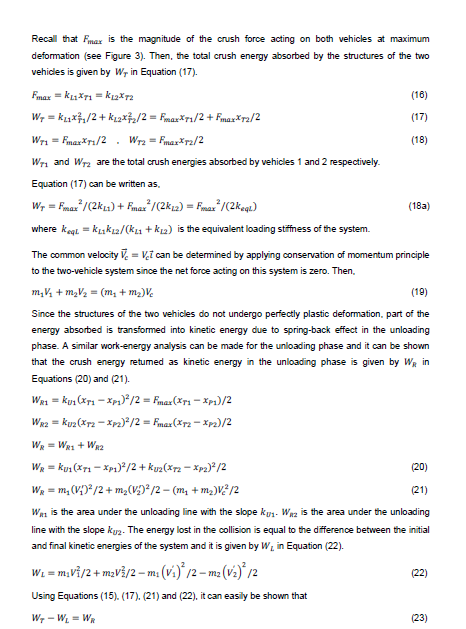1) Consider a central in-line head-on collision of two vehicles with rebound which is described show that the following relationships are true. WR1 _ kuz WR2 kui Wrkeql WR1 Wrkegl WR2 = ku2 kegl WR = WT kegu kegl e2 = kequ kui 1 where kegu kui kuz
1) Consider a central in-line head-on collision of two vehicles with rebound which is described show that the following relationships are true. WR1 _ kuz WR2 kui Wrkeql WR1 Wrkegl WR2 = ku2 kegl WR = WT kegu kegl e2 = kequ kui 1 where kegu kui kuz
College Physics
11th Edition
ISBN:9781305952300
Author:Raymond A. Serway, Chris Vuille
Publisher:Raymond A. Serway, Chris Vuille
Chapter10: Thermal Physics
Section: Chapter Questions
Problem 57AP
Related questions
Question
Question and Equation file in image
show that the
following relationships are true.

Transcribed Image Text:Recall that Fmax is the magnitude of the crush force acting on both vehicles at maximum
deformation (see Figure 3). Then, the total crush energy absorbed by the structures of the two
vehidles is given by Wr in Equation (17).
Fmax = k1X71 = kax7a
(16)
W, = kx,/2 + kı2X,/2 = FmaxXT1/2 + Fmaz*r2/2
(17)
Wr1 = FmaxXr1/2
. Wrz = Fmas*rz/2
(18)
Wri and Wrz are the total crush energies absorbed by vehicles 1 and 2 respectively.
Equation (17) can be written as,
W, = Fmax /(2ka) + Fmar /(2k12) = Fimar /(2keqı)
(18a)
where kegl = kukı2/(kLı + k12) is the equivalent loading stiffness of the system.
The common velocity V. = Vi can be determined by applying conservation of momentum principle
to the two-vehicle system since the net force acting on this system is zero. Then.
m,V, + m2V½ = (m, + m2)V,
(19)
Since the structures of the two vehicles do not undergo perfectly plastic deformation, part of the
energy absorbed is transformed into kinetic energy due to spring-back effect in the unloading
phase. A similar work-energy analysis can be made for the unloading phase and it can be shown
that the crush energy retumed as kinetic energy in the unloading phase is given by Wa in
Equations (20) and (21).
Wa1 = ku, (Xr1 - Xp1)*/2 = Fmaz (Xr1 – Xp1)/2
WR2 = kuz (Xr2 -Xp2)/2 = Fmar(Xrz - Xp2)/2
WR = WR1 + WR2
We = kui (X71 – Xp1)*/2 + kuz(X72 – Xpa)* /2
(20)
- m, (V;)*/2 + m,(V£D* /2 - (m, + m2)V? /2
WR =
(21)
Wan is the area under the unloading line with the slope ku1- Waz is the area under the unloading
line with the slope kyz. The energy lost in the collision is equal to the difference between the initial
and final kinetic energies of the system and it is given by W, in Equation (22).
Wi = m,vi/2 + m2vš/2 - m: (vi)* /2 – m2 (v^)° /2
(22)
Using Equations (15). (17). (21) and (22), it can easily be shown that
W, - WL = WR
(23)

Transcribed Image Text:1) Consider a central in-line head-on collision of two vehicles with rebound which is described
show that the
following relationships are true.
keql
kequ
kegl
WR1 _ ku2
WR2 ku1
Wrkeql
Wr1
Wrkegl
Wr2
WR = Wr-
kequ
kui
kuz
1
1
1
where
kegu kui ' ku2
Expert Solution
This question has been solved!
Explore an expertly crafted, step-by-step solution for a thorough understanding of key concepts.
Step by step
Solved in 4 steps with 4 images

Knowledge Booster
Learn more about
Need a deep-dive on the concept behind this application? Look no further. Learn more about this topic, physics and related others by exploring similar questions and additional content below.Recommended textbooks for you

College Physics
Physics
ISBN:
9781305952300
Author:
Raymond A. Serway, Chris Vuille
Publisher:
Cengage Learning

College Physics
Physics
ISBN:
9781938168000
Author:
Paul Peter Urone, Roger Hinrichs
Publisher:
OpenStax College

College Physics
Physics
ISBN:
9781305952300
Author:
Raymond A. Serway, Chris Vuille
Publisher:
Cengage Learning

College Physics
Physics
ISBN:
9781938168000
Author:
Paul Peter Urone, Roger Hinrichs
Publisher:
OpenStax College